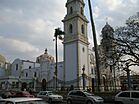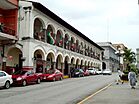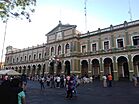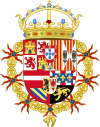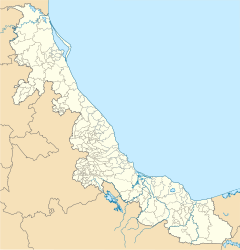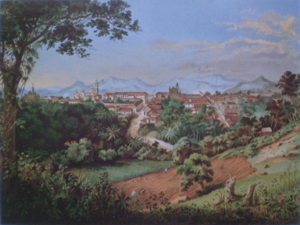Córdoba, Veracruz facts for kids
Quick facts for kids
Córdoba
|
||
|---|---|---|
|
City
|
||
|
Top: Panoramic view of Córdoba main square; Middle: San Antonio de Padua Church, Immaculate Conception Cathedral; Bottom: Portal de la Gloria, Córdoba Municipal Hall
|
||
|
||
| Nickname(s):
La ciudad de los 30 caballeros (The City of the Thirty Gentlemen)
|
||
| Country | ||
| State | Veracruz | |
| Region | Mountains Region | |
| Founded | 1618 | |
| Area | ||
| • Total | 159.9 km2 (61.7 sq mi) | |
| Elevation
(of seat)
|
860 m (2,820 ft) | |
| Population
(2020)
|
||
| • Total | 204,721 | |
| • Density | 1,208.4/km2 (3,130/sq mi) | |
| • Seat | 139,075 | |
| • Metro | 335,950 | |
| • Metro density | 727.63/km2 (1,884.6/sq mi) | |
| Time zone | UTC-6 (Central (US Central)) | |
| Postal code (of seat) |
94500
|
|
| Website | cordoba.gob.mx | |
| Historical population | ||
|---|---|---|
| Year | Pop. | ±% |
| 1995 | 168,760 | — |
| 2000 | 177,280 | +5.0% |
| 2005 | 186,623 | +5.3% |
| 2010 | 196,541 | +5.3% |
| 2015 | 218,153 | +11.0% |
| 2020 | 204,721 | −6.2% |
Córdoba, also known as Heroica Córdoba, is a city in the Mexican state of Veracruz. It was founded a long time ago in 1618. It is the main city of the area, called a municipality.
The city is made up of 15 neighborhoods. It is surrounded by other towns like Ixhuatlán del Café, Tomatlán, Amatlán de los Reyes, and Naranjal.
Córdoba covers an area of about 159.9 square kilometers. It has 95 smaller areas, with the most important ones being San Román, Crucero Nacional, La Luz y Trinidad Palotal, and Colorines.
This city is also called The City of the Thirty Knights. This is because 30 Spanish noblemen were sent by a leader named Viceroy Fernández de Córdoba to found it.
Córdoba is famous for its history, old colonial buildings, cultural places, parks, and delicious food. It is part of a larger group of cities, including Fortín, Amatlán, and Yanga. Together, they form an important metropolitan area with over 335,000 people.
Contents
Where is Córdoba Located?
Córdoba is in the middle of the state of Veracruz. It sits between two hills, Matlaquiahitl and Tepixtepec. The city is about 817 meters (2,680 feet) above sea level.
The weather in Córdoba is warm and humid. The average temperature is around 19.8°C (67.6°F) each year. It rains a lot in the summer and autumn, but not much in winter.
What is Córdoba's History?
Colonial Times
The city of Córdoba was started in 1618 by the Spanish. They wanted to protect their interests from attacks by a group led by Gaspar Yanga. He was a leader of a slave rebellion.
Mexican Independence
In August 1821, Mexican rebel forces took control of the city. After this, two important leaders, Agustín de Iturbide (a Mexican revolutionary) and Juan de O'Donojú (the Spanish viceroy), signed a special agreement here. This agreement was called the Treaty of Córdoba. It officially confirmed Mexico's independence from Spain.
Modern Era
In 1973, a big earthquake caused a lot of damage to the city.
What is the Economy Like?
The main ways people make money in Córdoba are through farming, raising animals, industry, and trade.
- Farming: Farmers grow crops like sugar cane, coffee, avocado, oranges, lemons, and rice. They also grow special flowers like anturios and heliconias.
- Industry: Córdoba is a key place for processing sugar and coffee. It's also important for selling and preparing tropical fruits.
- Workforce: There are many workers available, and wages are relatively low. This makes it a good place for industries to set up.
A highway connects Córdoba to Veracruz, which is the state's main port. This helps with trade and transportation.
Healthcare and Entertainment
Córdoba has many hospitals and clinics that provide health services. These include public hospitals like ISSSTE and IMSS. There is also a local Red Cross hospital and several private hospitals.
The city offers many fun places to visit. You can find billiard halls, dance halls, and discothèques. Córdoba also has three libraries, three auditoriums, a theater, and a museum for learning and entertainment.
How Do People Get Around?
From 1902 to 1953, Córdoba had a special narrow gauge railroad. This train line was unique and scenic. It helped people travel to and from Coscomatepec.
Who Lives in Córdoba?
As of 2020, about 204,721 people live in the municipality of Córdoba. About 139,075 of them live in the main city area. This makes Córdoba the 6th largest city in Veracruz state. Other important areas nearby include San Román, Crucero Nacional, La Luz y Trinidad Palotal, and Colorines.
What are Some Famous Places?
One of the most important places in Córdoba is its main square, called the Parque de 21 de Mayo. It's set up in the traditional Spanish way. There's a church on one side, the city hall (Palacio Municipal) on another, and shops all around.
The Paso Coyol Ecological Park is a special park that used to be an empty lot. It's about 4 hectares (10 acres) big and focuses on being eco-friendly.
Famous People from Córdoba
Many notable people have come from Córdoba, including:
- Jorge Cuesta (1903–1942), a chemist and writer.
- Rubén Bonifaz Nuño (1923–2013), a poet and translator.
- Emilio Carballido (1925–2008), a writer and dramatist.
Sports Stars
Córdoba has also produced talented athletes:
- Santiago González (tennis) (born 1983), a professional tennis player.
- Miguel Layún (born 1988), a professional football (soccer) player who played for the Mexican national team.
- Raúl Mendoza (born 1991), a professional wrestler with WWE.
- Luis Cessa (born 1992), a Major League Baseball pitcher.
Sister Cities
Córdoba has a "sister city" relationship with another city:
 Baton Rouge, Louisiana, United States, since 2002. This means they share cultural ties and friendly relations.
Baton Rouge, Louisiana, United States, since 2002. This means they share cultural ties and friendly relations.
See also
 In Spanish: Córdoba (México) para niños
In Spanish: Córdoba (México) para niños



